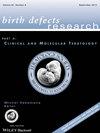Cell death and cell proliferation in human spina bifida.
Q Medicine
Birth defects research. Part A, Clinical and molecular teratology
Pub Date : 2016-02-01
DOI:10.1002/bdra.23466
引用次数: 5
Abstract
BACKGROUND Spina bifida is a multifactorial congenital malformation of the central nervous system. The aim of this study was to ascertain the relevance of cell death/proliferation balance in human spina bifida and to assess autophagy distribution and levels during embryo-fetal development in neural tissue. METHODS Five human cases with myelomeningocoele were compared with 10 healthy human controls and LC3 protein expression was also analyzed in mouse embryos. Cell death was evaluated using TUNEL (terminal deoxynucleotidyl transferase-mediated deoxyuridinetriphosphate nick end-labeling) assay; cell proliferation was studied by counting Ki67-positive cells, and autophagy was assessed by observing the presence of LC3 punctuate dots. RESULTS Comparing human cases and controls (13 to 21 weeks of gestation), we observed a significant increase in TUNEL-positive cells in human spina bifida associated with a significantly decreased proliferation rate, indicating an alteration of the physiological cell rate homeostasis. LC3 distribution was found to be spatiotemporally regulated in both human and murine embryo-fetuses: in early pregnancy a diffuse and ubiquitous LC3 signal was detected. After neural tube closure, an intense LC3-positive signal, normally associated to extra energy requirement, was confined to the Lissauer's tract, the dorsolateral spinal zone containing centrally projecting axons from dorsal root ganglia, at any medullar levels. LC3 signal disappeared from 12 weeks of gestation. CONCLUSION In conclusion, this study confirms the fundamental role of cell death/proliferation balance during central nervous system development and reports the changing expression of LC3 protein in mouse and human neural tube. Birth Defects Research (Part A) 106:104-113, 2016. © 2015 Wiley Periodicals, Inc.人脊柱裂的细胞死亡和细胞增殖。
背景:脊柱裂是一种多因素的先天性中枢神经系统畸形。本研究的目的是确定人脊柱裂中细胞死亡/增殖平衡的相关性,并评估胚胎-胎儿发育期间神经组织中自噬的分布和水平。方法将5例脊髓脊膜膨出患者与10例正常人进行比较,分析LC3蛋白在小鼠胚胎中的表达情况。采用末端脱氧核苷酸转移酶介导的脱氧尿苷三磷酸缺口末端标记法(TUNEL)评估细胞死亡;通过计数ki67阳性细胞来观察细胞增殖,通过观察LC3标点点的存在来评估细胞自噬。结果将人类病例与对照组(妊娠13 ~ 21周)进行比较,我们观察到人类脊柱裂中tunel阳性细胞的显著增加与增殖率的显著降低相关,表明生理细胞率稳态的改变。LC3的分布在人类和小鼠胚胎胎儿中均受时空调节:在妊娠早期检测到弥漫性和普遍存在的LC3信号。神经管关闭后,强烈的lc3阳性信号,通常与额外的能量需求有关,被限制在利索束(Lissauer's tract),脊髓背外侧区包含来自背根神经节的中央突出轴突,在任何髓质水平。妊娠12周后LC3信号消失。结论本研究证实了细胞死亡/增殖平衡在中枢神经系统发育过程中的重要作用,并报道了LC3蛋白在小鼠和人神经管中的表达变化。出生缺陷研究(A辑)106:104-113,2016。©2015 Wiley期刊公司
本文章由计算机程序翻译,如有差异,请以英文原文为准。
求助全文
约1分钟内获得全文
求助全文
来源期刊

Birth defects research. Part A, Clinical and molecular teratology
医药科学, 胎儿发育与产前诊断, 生殖系统/围生医学/新生儿
CiteScore
1.86
自引率
0.00%
发文量
0
审稿时长
3 months
 求助内容:
求助内容: 应助结果提醒方式:
应助结果提醒方式:


